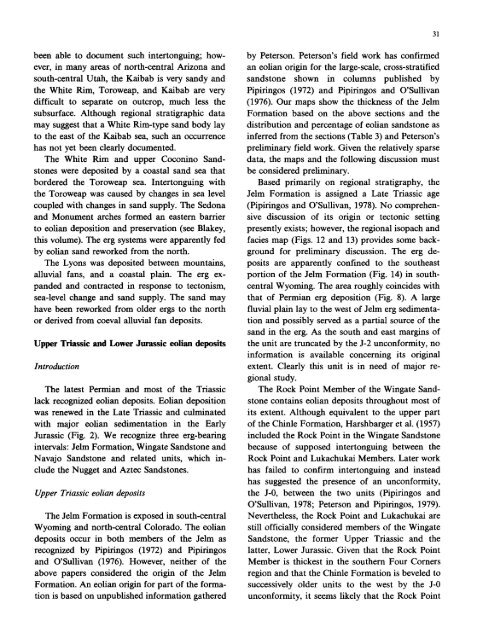Synthesis of late Paleozoic and Mesozoic eolian deposits of the ...
Synthesis of late Paleozoic and Mesozoic eolian deposits of the ...
Synthesis of late Paleozoic and Mesozoic eolian deposits of the ...
Create successful ePaper yourself
Turn your PDF publications into a flip-book with our unique Google optimized e-Paper software.
een able to document such intertonguing; how-<br />
ever, in many areas <strong>of</strong> north-central Arizona <strong>and</strong><br />
south-central Utah, <strong>the</strong> Kaibab is very s<strong>and</strong>y <strong>and</strong><br />
<strong>the</strong> White Rim, Toroweap, <strong>and</strong> Kaibab are very<br />
difficult to separate on outcrop, much less <strong>the</strong><br />
subsurface. Although regional stratigraphic data<br />
may suggest that a White Rim-type s<strong>and</strong> body lay<br />
to <strong>the</strong> east <strong>of</strong> <strong>the</strong> Kaibab sea, such an occurrence<br />
has not yet been clearly documented.<br />
The White Rim <strong>and</strong> upper Coconino S<strong>and</strong>-<br />
stones were deposited by a coastal s<strong>and</strong> sea that<br />
bordered <strong>the</strong> Toroweap sea. Intertonguing with<br />
<strong>the</strong> Toroweap was caused by changes in sea level<br />
coupled with changes in s<strong>and</strong> supply. The Sedona<br />
<strong>and</strong> Monument arches formed an eastern barrier<br />
to <strong>eolian</strong> deposition <strong>and</strong> preservation (see Blakey,<br />
this volume). The erg systems were apparently fed<br />
by <strong>eolian</strong> s<strong>and</strong> reworked from <strong>the</strong> north.<br />
The Lyons was deposited between mountains,<br />
alluvial fans, <strong>and</strong> a coastal plain. The erg ex-<br />
p<strong>and</strong>ed <strong>and</strong> contracted in response to tectonism,<br />
sea-level change <strong>and</strong> s<strong>and</strong> supply. The s<strong>and</strong> may<br />
have been reworked from older ergs to <strong>the</strong> north<br />
or derived from coeval alluvial fan <strong>deposits</strong>.<br />
Upper Triassic <strong>and</strong> Lower Jurassic <strong>eolian</strong> <strong>deposits</strong><br />
Introduction<br />
The <strong>late</strong>st Permian <strong>and</strong> most <strong>of</strong> <strong>the</strong> Triassic<br />
lack recognized <strong>eolian</strong> <strong>deposits</strong>. Eolian deposition<br />
was renewed in <strong>the</strong> Late Triassic <strong>and</strong> culminated<br />
with major <strong>eolian</strong> sedimentation in <strong>the</strong> Early<br />
Jurassic (Fig. 2). We recognize three erg-bearing<br />
intervals: Jelm Formation, Wingate S<strong>and</strong>stone <strong>and</strong><br />
Navajo S<strong>and</strong>stone <strong>and</strong> re<strong>late</strong>d units, which in-<br />
clude <strong>the</strong> Nugget <strong>and</strong> Aztec S<strong>and</strong>stones.<br />
Upper Triassic <strong>eolian</strong> <strong>deposits</strong><br />
The Jelm Formation is exposed in south-central<br />
Wyoming <strong>and</strong> north-central Colorado. The <strong>eolian</strong><br />
<strong>deposits</strong> occur in both members <strong>of</strong> <strong>the</strong> Jelm as<br />
recognized by Pipiringos (1972) <strong>and</strong> Pipiringos<br />
<strong>and</strong> O'Sullivan (1976). However, nei<strong>the</strong>r <strong>of</strong> <strong>the</strong><br />
above papers considered <strong>the</strong> origin <strong>of</strong> <strong>the</strong> Jelm<br />
Formation. An <strong>eolian</strong> origin for part <strong>of</strong> <strong>the</strong> forma-<br />
tion is based on unpublished information ga<strong>the</strong>red<br />
by Peterson. Peterson's field work has confirmed<br />
an <strong>eolian</strong> origin for <strong>the</strong> large-scale, cross-stratified<br />
s<strong>and</strong>stone shown in columns published by<br />
Pipiringos (1972) <strong>and</strong> Pipiringos <strong>and</strong> O'Sullivan<br />
(1976). Our maps show <strong>the</strong> thickness <strong>of</strong> <strong>the</strong> Jelm<br />
Formation based on <strong>the</strong> above sections <strong>and</strong> <strong>the</strong><br />
distribution <strong>and</strong> percentage <strong>of</strong> <strong>eolian</strong> s<strong>and</strong>stone as<br />
inferred from <strong>the</strong> sections (Table 3) <strong>and</strong> Peterson's<br />
preliminary field work. Given <strong>the</strong> relatively sparse<br />
data, <strong>the</strong> maps <strong>and</strong> <strong>the</strong> following discussion must<br />
be considered preliminary.<br />
Based primarily on regional stratigraphy, <strong>the</strong><br />
Jelm Formation is assigned a Late Triassic age<br />
(Pipiringos <strong>and</strong> O'Sullivan, 1978). No comprehen-<br />
sive discussion <strong>of</strong> its origin or tectonic setting<br />
presently exists; however, <strong>the</strong> regional isopach <strong>and</strong><br />
facies map (Figs. 12 <strong>and</strong> 13) provides some back-<br />
ground for preliminary discussion. The erg de-<br />
posits are apparently confined to <strong>the</strong> sou<strong>the</strong>ast<br />
portion <strong>of</strong> <strong>the</strong> Jelm Formation (Fig. 14) in south-<br />
central Wyoming. The area roughly coincides with<br />
that <strong>of</strong> Permian erg deposition (Fig. 8). A large<br />
fluvial plain lay to <strong>the</strong> west <strong>of</strong> Jelm erg sedimenta-<br />
tion <strong>and</strong> possibly served as a partial source <strong>of</strong> <strong>the</strong><br />
s<strong>and</strong> in <strong>the</strong> erg. As <strong>the</strong> south <strong>and</strong> east margins <strong>of</strong><br />
<strong>the</strong> unit are truncated by <strong>the</strong> J-2 unconformity, no<br />
information is available concerning its original<br />
extent. Clearly this unit is in need <strong>of</strong> major re-<br />
gional study.<br />
The Rock Point Member <strong>of</strong> <strong>the</strong> Wingate S<strong>and</strong>-<br />
stone contains <strong>eolian</strong> <strong>deposits</strong> throughout most <strong>of</strong><br />
its extent. Although equivalent to <strong>the</strong> upper part<br />
<strong>of</strong> <strong>the</strong> Chinle Formation, Harshbarger et al. (1957)<br />
included <strong>the</strong> Rock Point in <strong>the</strong> Wingate S<strong>and</strong>stone<br />
because <strong>of</strong> supposed intertonguing between <strong>the</strong><br />
Rock Point <strong>and</strong> Lukachukai Members. Later work<br />
has failed to confirm intertonguing <strong>and</strong> instead<br />
has suggested <strong>the</strong> presence <strong>of</strong> an unconformity,<br />
<strong>the</strong> J-0, between <strong>the</strong> two units (Pipiringos <strong>and</strong><br />
O'Sullivan, 1978; Peterson <strong>and</strong> Pipiringos, 1979).<br />
Never<strong>the</strong>less, <strong>the</strong> Rock Point <strong>and</strong> Lukachukai are<br />
still <strong>of</strong>ficially considered members <strong>of</strong> <strong>the</strong> Wingate<br />
S<strong>and</strong>stone, <strong>the</strong> former Upper Triassic <strong>and</strong> <strong>the</strong><br />
latter, Lower Jurassic. Given that <strong>the</strong> Rock Point<br />
Member is thickest in <strong>the</strong> sou<strong>the</strong>rn Four Corners<br />
region <strong>and</strong> that <strong>the</strong> Chinle Formation is beveled to<br />
successively older units to <strong>the</strong> west by <strong>the</strong> J-0<br />
unconformity, it seems likely that <strong>the</strong> Rock Point<br />
31

















